Recent Posts
Best Practices for Screening Reliable Tenants
4/15/2025 (Permalink)
 Happy tenants getting new keys
Happy tenants getting new keys
Best Practices for Screening Reliable Tenants
A thorough vetting process can pay off when screening potential tenants for residential rental properties. Comprehensive screening using best practices can minimize risks. It can also benefit tenants and landlords by establishing clear expectations throughout the transaction. Quality tenants reduce turnover and help landlords deliver a safe, well-maintained property and living experience.
1. Create a Comprehensive Rental Application
Start the search for reliable tenants with a detailed rental application. Get full tenant contact information, including cell phone numbers, email addresses, and emergency contacts, to assemble the applicant's background. To ensure tenants qualify for the lease, include a request for proof of income documents and recent employment history.
Add checkboxes with accompanying text asking tenants to give their consent for credit and background checks. Include space for at least two to three landlord and personal references. Add free space, and ask applicants to provide details on their most recent rental experience. Additionally, ask for commentary that could provide insight into the tenant's priorities and needs.
2. Verify Employment and Income
Assess a prospect's employment and income to confirm they can cover monthly lease payments. Don't just take their word for it. Validate with bank statements, pay stubs, or tax returns.
If feasible, contact the person's employer to verify claims about their pay. In some cases, the tenant might need more support to get clarity. For a good cross-check, compare income claims against the industry average for the person's job type.
3. Perform a Thorough Credit Check
Evaluate if the tenant can handle the lease payment and other monthly bills by checking their credit. Remember to verify the tenant has checked the “OK” box to consent to a comprehensive credit report. Check their credit scores from the three bureaus (Equifax, Experian, and TransUnion) and calculate the debt-to-income ratios.
Negative information may only show on one bureau’s report. Hence, one of the best practices for screening reliable tenants is to invest the time in reviewing all three bureau credit reports to capture the full picture. Look for patterns of rent defaults or chronic late payments. Use this information to decide on the applicant's risk level.
4. Review References and Rental History
Follow up on the landlord and reference contacts to determine the tenant’s reliability. Tenants can give false references, so invest the time to contact them. A situation may also warrant further verifying the contacts using property records and other information to ensure they are legitimate references. Ask about payment history, the number of late payments, and any evictions carried out.
Request information on the individual’s upkeep of their former unit and whether they caused any damage or left it in poor shape when they moved out. Check notes the tenant gave on their application against feedback from the references. Ask former landlords how long the tenant lived in their rental. Their responses shouldn't be much different than the tenant's application.
5. Evaluate the Background Check
When using the best practices for screening reliable tenants, it's crucial for tenant security and the property's safety to run a thorough background check. Use a service that can run comprehensive screens for criminal backgrounds. Verify that the prospective tenant has no court-related or active legal issues, like multiple or open bankruptcies.
Some situations are subjective, so consider the timeline for negative events or past offenses to decide whether they are still relevant. Consider the context of past incidents and how the tenant ultimately resolved them. Assess information from the background check with other sections of the tenant’s application.
6. Meet Prospective Tenants In Person
Set up a time to talk with tenants in person to gauge their commitment and character. Review the lease application together and ask additional questions to clarify or cross-check. Ask about the individual’s future plans to ensure they fit within the property guidelines.
Topics can include guest frequency and number of overnight guests. Don't forget about potential pets and lifestyle or work/school schedule. Ensure their activities fit within the property’s rules and noise levels. Observe the tenant’s overall demeanor and communication skills. Use this opportunity to address any application-related concerns or issues. Clear up issues that could affect their ability to keep within the terms of the rental or lease agreement.
7. Assess Tenant Compatibility
Consider how an applicant and their lifestyle fit within the property and community. Find out about the individual’s typical daily routines, habits, or hobbies. They might not give an honest answer, but it's worth asking if their behaviors have disturbed other tenants before. Offending habits include smoking on the unit's patio or loud, late-night electric guitar practice.
If the tenant has a pet, learn more about the animal's size and type. Consider having a pet interview to assess the animal's behavior and temperament to ensure it can coexist with the community. Include an addendum to the lease contract outlining pet owners' responsibilities. The individual is required to acknowledge this by signing the document.
Check social media sites to confirm consistency between the tenant’s application and their online persona. Look for any signs of risky or irresponsible behavior. However, social media activity should be a secondary source to support the other information gathered in the application and in-person interview. This process should allow for a good assessment of the tenant’s ability to respect shared spaces and achieve long-term compatibility with other residents.
8. Review the Tenant’s Property Maintenance History
Knowing how a tenant has maintained their previously rented properties is an essential best practice for screening reliable tenants to protect the value of the property investment. Ask tenants to provide evidence of how they maintained their previous unit. Confirm that the tenant can handle minor fixes and property upkeep.
The individual might talk about maintenance or repairs they performed at previous rentals. Ask for photos or a reference contact for verification. Evaluate the tenant’s ability and desire to proactively report maintenance issues. Less desirable tenants might let things go unaddressed or do a DIY fix themselves. For bigger issues like smoke damage cleanup process, professional service is warranted.
9. Assess Responsiveness and Communication
Good tenants typically communicate effectively and respond in a timely manner. During the application process, see if the tenant shares information. Try various channels such as phone or email. Consider the speed of their responses. Ask about their preferred ways of staying in touch. Assess how well the individual handles follow-up requests and in-depth questions.
10. Evaluate Long-Term Commitment Potential
In some cases, tenants may reveal clues about whether they're a possible long-term rental candidate. An easy "tell" is how long the person lived at previous rental properties. Inquire about their plans, such as whether they intend to remain in the area long-term due to a job nearby or younger children attending school. These life stages can motivate them to settle in the property longer.
Ask if the tenants have strong local ties, such as family. Compiling this information can give clues as to whether the tenant’s goals align with stability and a long-term stay. During the tenant interview, consider various lease renewal scenarios that may encourage quality tenants to stay on a long-term rental basis.
11. Review the Lease Terms Thoroughly
Start tenant relationships on the right foot by setting clear expectations from the first meeting. Work through a detailed review of the lease terms and legal responsibilities of the lease contract with the prospective lessee. Ensure the rental package includes detailed documents that outline the responsibilities of both tenant and landlord.
Best practices for screening reliable tenants include explaining essential rules and guidelines to the tenant regarding late payments, maintenance and repairs, and pet policies. Before signing, confirm that the tenant understands all the contract’s legal terms and is comfortable with each condition outlined in the document.
Invest in Finding Reliable Tenants
Sifting through rental applications to find reliable, quality tenants is not a perfect science. It takes several steps to collect data, some additional detective work, and perhaps a little intuition. When it comes to keeping properties in good repair to attract reliable tenants, landlords may be looking for "vent cleaning services near me" to ensure good indoor air quality and rental properties free of allergens, residual smoke, or mold. Look no further than the skilled professionals at SERVPRO®. Let our expert services become one of your best practices when maintaining valuable property investments. Contact us today!
Signs of Hidden Water Damage in Walls
4/9/2025 (Permalink)
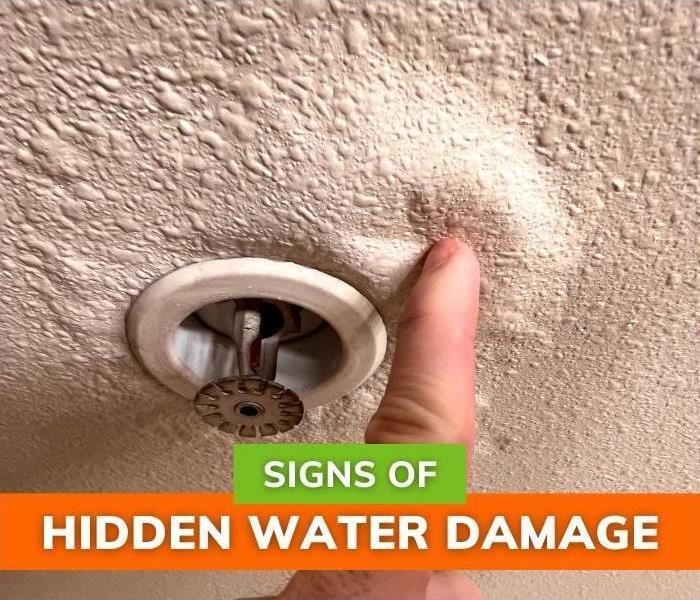 Water damage in the wall
Water damage in the wall
Signs of Hidden Water Damage in Walls
Sometimes, water damage leaves obvious signs, such as leaky pipes or water puddles on the floor. However, leaks can also start behind your walls and slowly deteriorate your pipes, building materials, and insulation. When you find the leak, you already have ruined drywall or significant mold contamination.
Knowing the signs of hidden water damage in walls can help you catch leaks early on. If you suspect water damage, HVAC professionals can inspect your pipes, walls, floors, and ceiling to find the source and repair the issue. They can also assist you during post-fire property recovery.
What Causes Hidden Water Damage?
Once you detect signs of hidden water damage in walls, you'll need to find the source to prevent further damage. Common causes of water damage include:
- Floodwaters
- Excessive condensation
- Clogged or leaking pipes
- Gaps in your roof
- Foundation cracks
- Broken appliances
- Inadequate window seals
Clean water doesn't contain pollutants, making it safer to handle. Some appliances produce grey water, which contains food particles. Black water is sewage that may contaminate your house with bacteria, parasites, and feces. This kind of water damage requires you to sanitize the space.
What Are the Signs of Water Damage?
Soft Drywall
When water seeps into drywall, the material eventually softens and crumbles, leaving you with stained, sagging drywall that detracts from your home's appearance. If you have wallpaper, look out for peeling or discoloration. Wet drywall is often a breeding ground for mold and mildew. Worse, the drywall could eventually collapse and threaten your home's integrity.
Typically, professionals remove the damaged drywall before the moisture spreads any further. They might cut out the damaged section and dry the area, then replace any building materials that experienced water damage. If mold is a concern, they could sanitize your wall. Finally, they'll add new drywall and paint the area to make it look seamless.
Peeling Paint
As water trickles down your wall, the paint might feel soft and moist. Bubbling, flaking, and chipping are common. If you try to repaint your wall, the paint will flake off again, so contact water restoration experts. They'll clean and dry your wall so that you can remove the discolored paint and apply a fresh coat.
Trickling Water Sounds
Mysterious trickling sounds indicate that you have a leak that you can't see. The leak causes damage inside your walls that you might not notice until drywall collapses or your paint starts deteriorating. If you hear trickling noises, call for help as soon as possible.
Mold Growth
Mold and mildew growth are two of the biggest signs of hidden water damage to walls. When you enter a contaminated room, you may notice musty odors, sagging ceilings, and black splotches or discoloration on the walls. Mold exposure causes flu-like symptoms, such as coughing, sneezing, red eyes, and headaches. People with asthma could suffer from frequent attacks.
You can remove small mold patches yourself. However, if you have significant mold growth inside your walls, consider hiring professionals to open your walls, remove the spores, seal the leak, and dry the area. Additionally, if spores enter the ductwork, you might need to clean your entire house. Your HVAC system could circulate spores throughout your house, leading to further contamination.
High Water Bills
If your water bills keep rising and you haven't used more water than usual, you probably have a leak. During water damage restoration, professionals use tools to locate the source and shut off the leak. Afterward, they'll determine if you have clean water, grey water, or black water, then survey the damage and move furniture out of the way.
Excessive Humidity
While some condensation on your window is normal, excessive moisture may indicate a leak inside your walls. Check the seals around your doors and windows to see if they let moisture inside your house.
Wet Insulation
Wet insulation is typically less effective, creating cold patches in your house. Mold and mildew can also grow inside the insulation. If you have a small patch of wet insulation, you can dry it out. Otherwise, hire experts to replace your insulation before it contaminates your space with bacteria.
Low Water Pressure
Low water pressure may indicate that your pipes have sprung a leak. As water spills out of the gap, your faucet produces a trickle instead of a full blast. Leaks are particularly common in older houses with outdated and corroded pipes.
Efflorescence
Efflorescence is a white, chalky substance that you find on wood, brick or concrete walls. This substance indicates that you have water leaking and drying on your walls, leaving salts and minerals behind. Over time, the water gradually seeps into your walls and weakens the structure until they're in danger of collapsing.
You can clean efflorescence off the surface, but you'll need to repair the leak to keep it from happening again. Some homeowners cover their walls with waterproofing chemicals to prevent excess moisture.
Invest in Commercial Air Duct Cleaning
If you detect musty smells, mold mildew growth, or poor indoor air quality (IAQ) in your house, contact SERVPRO® of Arcadia to learn more about commercial air duct cleaning. We'll use professional equipment to clean your ducts, improving their efficiency and boosting your IAQ. This service also extends your ductwork's lifespan.
Top Fireproofing Solutions for Homeowners
3/28/2025 (Permalink)
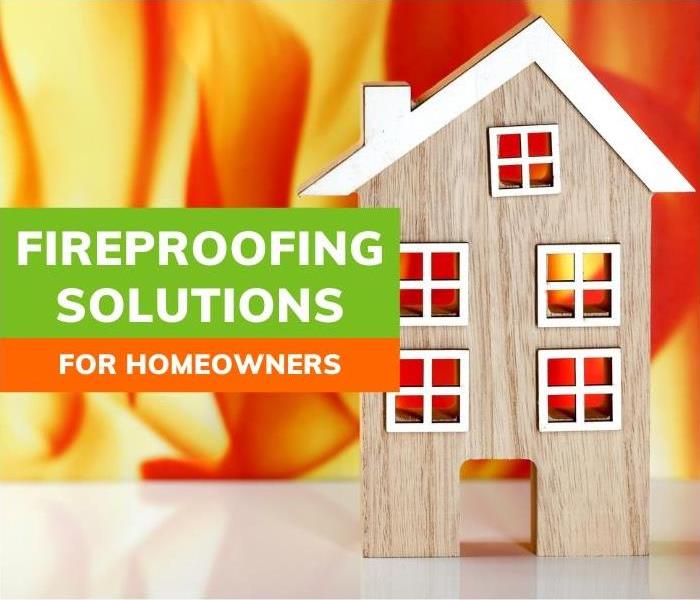 Model house in front of a fire
Model house in front of a fire
Top Fireproofing Solutions for Homeowners
Fire safety measures are critical for homeowners, especially those in fire-prone areas. Proactively fireproofing a home helps maintain its value while protecting its precious occupants.
Whether upgrading insulation or reworking the garden with fire-resistant plants, investing in these solutions can provide the vital seconds or minutes that make all the difference in an emergency.
Add Fire-Rated Insulation
Remove the home's existing insulation and install a safer, fire-rated product. This adds significant protection by hindering the spread of flames. Insulation materials like non-combustible mineral wool or ceramic fiber increase a home's resistance to high temperatures.
While the insulation slows the spread of fire, it also provides more time to safely remove loved ones from the structure and respond effectively to the threat. Fire-rated insulation complies with local safety regulations and may be required in critical spaces such as stairwells. As a bonus, fire-rated insulation also improves the home’s energy efficiency.
Integrate Fire-Resistant Materials
Various materials, such as fire-retardant coatings and fire-resistant building materials, offer enhanced protection. Some of the best fire protection comes from concrete, stucco, gypsum, and brick exteriors. Top home fireproofing solutions include using coatings made explicitly for wood surfaces, such as fire-retardant paint or primer coatings.
Add a clear fire-retardant coating to any surface to enhance a home's structure and aesthetics. This treatment extends the time for materials to ignite when exposed to flames. Retardants also reduce the ability of fire to spread to nearby structures. The coatings can be reapplied during periodic maintenance for continued protection.
Use Protective Building Materials
Renovating an existing home using fire-safe materials gives an extra layer of protection. Choose non-combustibles such as fiber cement siding, concrete, or certain types of stone, such as sandstone. Consider green solutions such as Timbercrete, made of recycled timber cellulose, which has natural fire-resistant properties and reduces the building’s carbon footprint. Metal and reinforced concrete building elements can add aesthetic beauty and additional protection.
Ensure the renovations adhere to local building codes and standards and choose tested certified products. Pay attention to whether materials are fire-resistant or fire-retardant. Fire-resistant materials are inherently resistant to catching fire, so they self-extinguish flames and do not drip or melt if exposed to heat. Fire-retardant materials have been treated with chemicals to make them self-extinguish, but the coating may need reapplication over time.
Invest in Fire-Resistant Windows and Doors
Fire-resistant windows and fire-rated doors help safeguard interior spaces as critical barriers to slow fire spread into and within a structure. Choose engineered glass windows that can withstand high temperatures and thermal shock without breaking. During a fire, the rapid temperature change can cause standard windows to break, allowing heat and flames to penetrate the home.
These windows typically have double panes that distribute heat more evenly and better protect against flames. The double panes also act as insulation for the home, increasing comfort and overall energy efficiency.
Fire-rated doors significantly slow the spread of fire into or within a home. They can withstand high temperatures and often come with seals to prevent smoke infiltration. Interior fire-rated doors can close off different areas, making it easier to contain flames, heat, and smoke. They also aid in safer exits during emergencies, making them one of the top fireproofing solutions for homeowners. After a fire, the home may require professional smoke damage services, and closing off sections with fire-rated doors can keep the damage and restoration work to a minimum.
Install Automatic Fire Sprinklers
Automatic home fire sprinkler systems provide a critical safety function by suppressing flames as soon as a fire starts. According to FEMA, fire sprinklers and smoke alarms reduce the risk of individuals dying in fires by 82%. Home fire sprinklers activate by sensing temperature changes, spraying only in the area of a fire. They reduce the flame, smoke, and heat, which makes it safer for home occupants and firefighters.
The systems can be installed during a renovation and are flush with the ceilings. Sprinklers minimize fire-related property damage and cause less destruction than water damage from firefighting hose lines.
Incorporate Advanced Systems for Fire Detection
Detecting a fire early can make all the difference between a minor event and catastrophic damage. Smoke alarms usually last about 10 years, so when it’s time for replacements, add heat and standard smoke detectors. Consider systems that have smart features, such as a mobile phone app that sends immediate notifications.
Ensure the sensors or detectors are inspected about once per month and tested periodically for proper maintenance. Place the detectors in strategic positions throughout the house and link them so that all the detectors sound if one sounds. Consider that once a smoke alarm sounds, home occupants may have less than two minutes to evacuate to a safe space.
Make Outdoor Spaces Defensible
Wildfires move quickly; something as small as a flying ember can endanger homes. Creating defensible space around the outside of a home reduces the risk of catching fire, which is another of the critical top fireproofing solutions for homeowners. Remove flammable debris and vegetation from yard areas around the structure. Create a buffer zone around the home using non-combustible materials such as gravel, concrete paths, patios, and stone retaining walls.
Avoid using combustible mulch in or around plant beds. Instead, substitute it with non-combustibles such as pea gravel or decomposed granite. Enhance the garden with fire-resistant plants, like succulents, agave, ice plants, and aloe. These plants retain moisture, resist burning, and act as a barrier to stop fire from spreading. Add fire-resistant shrubs and trees, keeping them trimmed and at least 10 feet from the home and potential sparks from a chimney.
Strategic Upgrades Provide Peace of Mind
Implementing solutions to make a home fire-proof is an essential investment for any homeowner. From installing fire-retardant building materials to adding home fire sprinklers, these upgrades can enhance safety and reduce the risk of fire damage.
As part of your home maintenance or fire restoration plan, add services like residential air duct cleaning to remove smoke, dust, and odors and to improve interior air quality. SERVPRO®'s qualified professionals can help you proactively keep your home safe and secure against fire. Contact us today for more information.
Ways to Improve Tenant Communication Channels
3/25/2025 (Permalink)
 Tenant talking to his landlord
Tenant talking to his landlord
Ways to Improve Tenant Communication Channels
Good communication allows tenants to feel good about where they live. For landlords and property owners, it can be easy to lose sight that the units you maintain are "home" to your tenants. For tenants, the idea of a "ghost" landlord who simply collects rent checks has become all too common. When landlords are absent or uncommunicative, this creates the impression that they don't care. Implementing some practices for communication between landlord and tenant can change the atmosphere. These seven tips for improving tenant communication channels show you where to start.
1. Have Standard Response Times for Queries and Emergencies
Don't disappear when tenants need you most! Unresponsiveness on the part of a landlord is one of the biggest sources of stress for tenants. Nobody wants to live with uncertainty when dealing with maintenance issues or needed repairs. It's important to respond promptly when tenants reach out for help. Consider having a dedicated email address or telephone line for maintenance emergencies. In addition, you should guarantee that all calls will be answered within a certain timeframe.
Don't forget to follow up after an issue is resolved. Reach out to tenants directly after maintenance requests have been fulfilled to ask if they're satisfied with the results. This should also be done whenever a tenant makes a complaint or request of any kind. It is powerful when tenants feel like landlords care about the outcome.
2. Use Multiple Communication Channels
This is especially important if you oversee a large rental complex. People have different preferences when it comes to how they communicate. When new tenants get welcome packets, they should include contact information that covers all common modes of communication. This includes phone, email, and written correspondence. When you need to share information with tenants, make sure you're broadcasting it through both email and SMS messages to boost visibility. High-priority items and official documents that require action on the part of the tenant should also be delivered as letters to tenant doors or mailboxes.
3. Do an Annual Tenant Survey
Asking tenants for feedback is an incredible way to help them feel valued. Create an annual survey that gauges tenant satisfaction based on multiple factors. Be sure to ask them to rate how they feel about your current approach to communication between landlords and tenants. While you may be putting effort into being communicative, a survey can reveal where tenants feel there's room for improvement.
4. Use Property Management Software
Is your communication with tenants struggling because you feel overwhelmed when managing requests or getting back to clients? Look into all-in-one property management software that lets you manage rent collection and tenant screening on the same platform that manages your messaging. Many newer software products for landlords allow you to send mass emails and text messages to your tenant list. In addition, many utilize chat features or automated response messages to ensure that tenant messages never get ignored when you're not in the office. The major benefit of using integrated property management software to communicate with clients is that you won't manually manage email or text lists.
5. Have Dedicated Office Hours
Don't make tenants run around trying to get five minutes of your time. Like most professionals, landlords and property managers should have official office hours. During these designated hours, tenants should be permitted to visit on a walk-in basis to discuss issues. Of course, priority can be given to tenants who book appointments during this window. When tenants are always met with a locked door when they attempt to visit with their landlord to bring up concerns or make requests, it can feel like the landlord is hiding from them. By making yourself available during office hours, you are showing tenants that you are a professional who proudly stands behind how an apartment complex operates.
6. Don't Hide Problems
Improving tenant communication channels can also be done by simply being honest with your tenants. Unfortunately, many renters today have trust issues regarding landlords because they've been taken advantage of in the past. It's common for renters to feel like landlords and property managers cut corners regarding maintenance and safety. To ensure that tenants feel valued, take the approach of fixing problems as soon as possible instead of trying to conceal them. Be transparent about the fact that the age or condition of a building creates the need for ongoing repairs or mitigation to ensure that all units are safe and livable. Every landlord should know how to repair smoke damage, manage water leaks and mold, and address critter infestations.
7. Create a Newsletter
Monthly or quarterly newsletters help to build a sense of community for tenants. They also provide landlords with a way to showcase happenings and improvements that are taking place around the complex. This can also be a friendly way to share changes in policy or procedural updates that impact tenants. As rental prices increase in most places around the country, newsletters also help tenants to see where their money is going. For example, a newsletter can be a place where a landlord shares improvements or upgrades that enhance the quality of life for tenants. This can include everything from newly paved walkways to updated washers and dryers in the laundry area.
Tenant Satisfaction Starts With Good Communication
Improving tenant communication channels doesn't have to start with a big gesture. Imagine how happy your tenants would be just to get an email letting them know that you're taking steps to improve indoor air quality in their units using professional duct cleaning. At SERVPRO®, we've helped landlords and property managers create safe homes for their tenants for decades. Contact us today to make sure maintenance issues don't stand in the way of a positive relationship between you and your tenants.
Steps to Take After Discovering Mold at Home
3/14/2025 (Permalink)
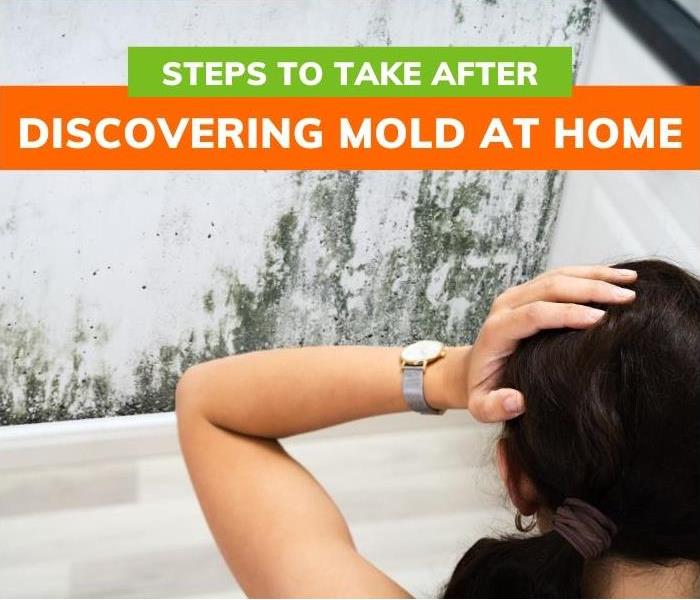 Woman Looking At Mold
Woman Looking At Mold
Steps to Take After Discovering Mold at Home
Discovering mold in your home can be distressing, but addressing it promptly and methodically can help prevent additional damage and risks to your family's health. Mold conditions become manageable by identifying the cause, limiting the spread, and using safe cleaning methods. A proactive approach to locating and treating mold infestations ensures a healthier home environment for the entire family.
Calmly Assess the Situation
Discovering mold in the home can be anxiety-provoking, but remaining calm makes it easier to handle the problem methodically. Without touching the mold, inspect the infected area to see the extent of mold growth and whether moisture is present. Before deciding on steps to take after discovering mold at home, determine if the infestation is limited to one section or has spread across several areas.
Conduct a “sniff” test to detect musty odors. This smell often indicates hidden mold, such as underneath carpets or behind furniture. Consider potential causes in the structure, such as flooding, leaks, or high humidity. Avoid disturbing the areas as much as possible to prevent microscopic mold spores from becoming airborne and spreading.
Locate Moisture Sources
Mold thrives in damp areas and humid conditions. Finding the source of moisture is vital to preventing further growth. Inspect the building, looking for plumbing leaks or water entry points in window frames or doors. If the building was involved in a fire, the fire damage cleanup might include removing excess moisture and mold. Examine the ceiling and walls, looking for stains indicating water leaks through the roof or inside the walls. Additionally, check the flooring for signs of warping.
Look for signs of mold damage in areas with frequent condensation, such as kitchens and bathrooms. Use a moisture meter tool to detect hidden moisture in walls, ceilings, and small areas such as crawl spaces. Address ongoing moisture issues, such as water leaks, before tackling the mold cleanup.
Limit Spore Spread
Mold spreads through invisible spores that float through the air, requiring careful handling to reduce the risk of further contamination. Avoid using the HVAC system or fans until the mold is safely contained. Cover vents and keep doors shut to close off the affected area. To seal the area off, use plastic sheeting taped to walls and ceilings for heavily contaminated spaces.
To prevent disturbing and releasing mold spores, minimize the movement of materials in the affected area. When handling moldy materials, wear protective masks, gloves, and other gear.
Assess the Severity
Mold problems do not always need professional remediation, but surveying the extent of the problem helps determine the next steps to take after discovering mold at home. Estimate the square footage of the affected area. Small building sections, such as 10 square feet or less, are often manageable with DIY cleaning solutions.
Larger areas of mold growth or those that have worsened to the point of affecting structural elements may need professional intervention. If the mold appears toxic, it is usually best to leave the job to professionals.
Take Health and Safety Precautions
Exposure to airborne mold spores in the home can trigger allergic reactions, respiratory issues, and physical discomfort, so it is essential to take protective precautions. Wear an N95 mask to prevent inhalation of mold spores. Minimize skin contact by wearing long sleeves and using gloves.
Keep sensitive people, such as children, elderly individuals, and those with respiratory conditions, away from infected rooms. Ventilate the areas, especially when using cleaning solutions. Wash hands and clothing thoroughly after handling materials or items contaminated by mold.
Use Safe DIY Mold Cleaning Methods
For minor problem areas, the proper steps after discovering mold at home can eliminate mold without spreading spores. Avoid using bleach solutions on porous materials such as wallboard, carpeting, and furniture because it will not reach the roots to completely kill the mold. Instead, use a specialized mold cleaner or a non-ammonia detergent.
Scrub the affected surfaces gently to avoid releasing mold spores into the air. Infected materials that cannot be adequately cleaned should be appropriately discarded to prevent a repeat mold infestation. To discourage regrowth, dry the cleaned-up area and address the issues that initially created the excessive moisture.
When DIY Is Not Enough
Sometimes, mold situations require more in-depth assessment and treatment to ensure the infestation is removed entirely and safely. A good guideline is to consider expert assessment and remediation when the affected area is larger than 10 square feet. The mold that has settled inside walls, the building’s air ducts, and hidden or hard-to-reach places like crawl spaces are often difficult to remove without specialized tools and equipment.
If an area has been cleaned but musty odors persist, additional hidden mold is likely. If any household members experience worsening allergies or unexplained health issues, an expert assessment is advised. The building’s air quality may need to be tested to determine the level of contamination.
Address Underlying Causes
Treating affected areas to remove mold is only effective if the source of the problem, moisture, is resolved. Improve ventilation in areas with excess humidity buildup, such as bathrooms. Use HEP air purifiers to capture any remaining mold spores and other allergens to prevent illness and spreading.
Repair leaks in pipes, windows, or roofs immediately. Inspect rain gutters to keep rainwater from pooling and seeping underneath roofing materials and into the home. Keep indoor humidity to 50% or below with the help of dehumidifiers. Consider whether a basement or crawl space requires waterproofing solutions to mitigate moisture-related issues.
Monitor for Recurrence
If moisture remains present, it creates favorable conditions for repeated mold growth, even after cleaning. Routinely inspect previously affected areas for signs of regrowth or moisture. Check basements, bathrooms, and other areas that tend to collect moisture.
Test the humidity levels in the home periodically and promptly address any ongoing problems, such as leaks or condensation. Schedule an inspection if odors or other signs of mold reappear after cleaning.
Take Preventative Action
Proactively handling a mold infestation can help prevent the hassle of dealing with it again in the future. Use mold-resistant paint in high-humidity areas such as kitchens and bathrooms. Ensure rooms have proper insulation to prevent condensation from building up. Store belongings in moisture-proof containers, especially those put away in attics and basements.
Have plumbing, roofing, and HVAC systems inspected regularly for potential mold or leak-related issues. Inform the family living at home of the importance and methods for moisture control.
Make Mold a Thing of the Past
Managing a mold infestation requires identifying the root cause, which is moisture. Even if the mold is cleaned up, without proper mitigation, the mold can come back, damaging your family's home and health. Regular maintenance, such as plumbing inspections, indoor humidity controls, and leak sealing, can help keep mold away for good. Additionally, HVAC system cleaning contributes to improved air quality and prevents the spread of mold spores to other areas of the home. Remain vigilant with the help of the professionals at SERVPRO®. Our experienced staff will help protect you and your loved ones from the threat of mold infestations. Contact us today for more information.
The Role of Technology in HOA Management
3/12/2025 (Permalink)
 HOA board software in laptop
HOA board software in laptop
The Role of Technology in HOA Management
The role of technology in HOA management has also grown as management responsibilities have evolved. In the past, board members of an HOA might have been able to manage a community simply by holding meetings a few times a year, but modern HOA management requires more.
Online portals for community engagement, software for event calendars, mobile apps, and community websites to keep member residents informed are just a few examples of the use of technology in modern HOA management. With technology being integrated into almost every facet of life, it only makes sense for HOAs to follow suit.
If you’re curious to learn more about how the role of technology in HOA management has pushed the industry to evolve, below are some key changes:
Technology to Ensure Safety and Security
Technology plays a large role in ensuring safety and security around HOA properties. Messaging apps and other technological advancements, combined with service request fulfillment software, can facilitate communication between residents and HOA staff to address maintenance requests. This can also make it easier and more efficient to address safety concerns.
For example, property restoration after fire damage can become a safety hazard if the issue isn’t addressed quickly. Residents can use communications technology to alert HOA management about concerns during fire damage cleanup, and restoration professionals can use the same technology to alert HOA staff about unsafe areas.
Of course, with a greater focus on technology in HOA management, data security becomes more important as well. HOA management should have security protocols, hardware, and software to protect sensitive personal and financial data surrounding communities, residents, and HOAs themselves.
How Technology Factors Into Financial Management of HOA Communities
Technology also plays an increasingly vital role in the management of HOA finances. As HOAs grow larger and managing assets, funds, and personnel becomes more complex, accounting software for financial reporting and tracking is crucial.
Not only are HOAs responsible for keeping up with dues, but they must also account for maintenance, repairs, salaries, and other expenses. Real-time property management financial software can help make this tracking and reporting more efficient, streamlining operations to avoid mistakes that can lead to audits and investigations.
Because some states may have special regulations for HOAs, financial management software also helps keep track of tax data for proper reporting. This may impact residents who own rental homes in HOA communities and are able to write off their dues as well.
Face-to-face Interaction is Still Vital
While technology has certainly opened up new ways for HOAs and residents to communicate, face-to-face interactions are still important. It may be more difficult for large HOAs that oversee multiple properties to provide personal representation in their communities, but offering access to a live person can make a difference.
This becomes all the more important in cases where disputes need to be resolved. If a resident of an HOA community cannot address concerns with a live representative of an HOA, small disputes can turn into larger conflicts. Although technology can facilitate some communication, providing access to a real person may make the difference between a peaceful resolution and a problem boiling over.
The Future of Technology in HOA Management
If the present is any indication, the role of technology in HOA management will continue to gain momentum going forward. As more and more people come to rely on mobile apps, instant messaging services, and notifications to juggle busy schedules, HOAs will undoubtedly adapt to changes.
For residents, this can mean a greater quality of life. For HOA management professionals, technology also represents opportunities to get more done faster and more efficiently. As with all technology, it’s vital to strike a balance to avoid putting all your eggs in one basket, but if you’re in the HOA management industry, now is the time to embrace technological advancements.
Contact SERVPRO® of Arcadia for Solutions to Make Your Life Easier in HOA Management
From professional air duct cleaning to restoration services, SERVPRO of Arcadia is the team to trust for turnkey community management solutions. We assist HOAs and property managers in keeping communities clean and safe, and our experts embrace the role of technology every step of the way.
Post-Fire Cleanup What to Do Next
3/5/2025 (Permalink)
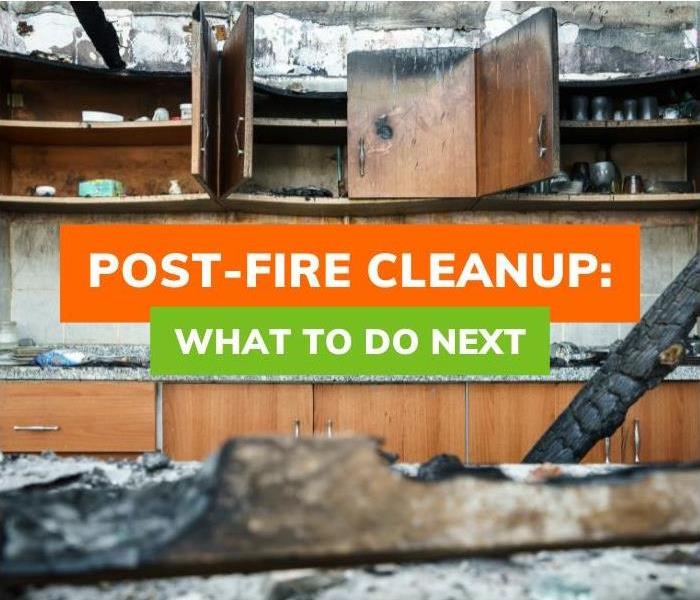 Kitchen after fire damage
Kitchen after fire damage
Post-Fire Cleanup What to Do Next
Having a home or commercial property exposed to fire is traumatic and can cause devastating losses. For properties that remain partially intact, restoration can seem dangerous and overwhelming. Following a process that focuses on safety and essential restoration steps can ensure the restoration work takes place with less stress.
1. Put Safety First
What should be done next for post-fire cleanup? After a fire, it is essential to prioritize personal safety before entering the building to start the cleanup process. Adopt protective gear, including an N95 mask or respirator, safety goggles, durable gloves, and sturdy shoes or work boots. Wear protective clothing that fully covers arms and legs.
Survey the property before entering, noting any visible structural damage that could make cleanup efforts unsafe. Avoid inhaling fumes or ash from soot-covered surfaces, and keep touching to a minimum to avoid toxic byproducts produced from the burned materials if you are not wearing gloves.
Pay attention to other potential hazards that could surface during the cleanup, such as gas leaks, exposed wires, and electrical hazards.
Avoid bringing family or pets inside the building until it has been thoroughly inspected, cleaned, and deemed safe for entry.
2. Notify the Insurance Company
The claims process can become time-consuming, so contact the insurer early to ensure prompt coverage and the necessary funds to cover needed repairs. Request that an adjuster come out to inspect as soon as possible and document all damage with photographs and video footage to share with them.
Ask for a copy of the insurance policy to learn what the coverage includes. To avoid complications with insurance coverage or reimbursement, do not make any permanent repairs to the structure until the insurance company has assessed the damage. In the meantime, keep all receipts for hotels or other temporary housing, food, and other expenses incurred while away from home.
3. Protect the Building
Unfortunately, intruders may attempt to enter burned structures after a fire, looking for valuables. To keep them out, board up broken windows and doors. Also, remove any valuables and important items that are salvageable.
For post-fire cleanup, what to do next includes turning off the water, gas, and electricity until inspectors can survey the property and ensure its safety. However, if the electrical panel or breaker looks damaged, wait for a professional to handle it. Any hissing sounds or gas smell could indicate a gas leak. In this case, leave the property immediately and contact the fire department. If the home's roof is damaged, cover it with an anchored tarp to keep moisture out in case of rain.
4. Assess the Building's Structural Integrity
It is essential to examine structures damaged by fire before entering. Certain weaknesses can endanger workers or hinder cleanup efforts. Look at the building’s major support beams and load-bearing walls for signs of charring. Inspect the ceilings, walls, and floors for visible cracks or signs of shifting. Additionally, check the building's foundation for signs of shifting, cracks, or other instability.
5. Address Water and Mold
Water used to extinguish a structure fire can create secondary problems if the building materials remain wet or the floor has pooling water. Mold growth can begin within 24 hours, making it essential to remove standing water as quickly as possible. Accelerate the drying-out process with the aid of large fans and dehumidifiers.
Dispose of waterlogged materials or belongings that cannot be salvaged, such as carpeting, drapes, or furniture. Treat the affected areas promptly with an especially formulated antimicrobial solution to discourage mold growth. Remember to inspect hidden areas, such as insulation and crawl spaces, for moisture that needs drying.
6. Restoration for Smoke Damage
Even if a house has not sustained fire damage, the smoke, ash, and other residue from a nearby fire can severely impact the home's internal air quality and leave toxic residues behind. For post-fire cleanup, what to do next includes immediately airing out the property by opening all windows and running air purifiers, such as those using high-efficiency particulate air (HEPA) filters. Wipe down all surfaces in the home with cleaners formulated to remove soot.
Smoke damage restoration includes hidden areas, such as the home's air ducts, which may require professional cleaning to remove debris and odors.
Dry-clean or wash all fabrics, including clothing, linens, and upholstery.
While waiting for odors to subside, minimize them by masking them with baking soda, activated charcoal, non-toxic air fresheners, or quality essential oils. If the odors persist, consider scheduling a professional ozone treatment.
7. Assess Salvageable Items
After a fire, some burned materials, such as charred or melted electronics, can release toxic or hazardous chemicals. Investigate local waste disposal guidelines to ensure these items are properly removed and disposed of. In some cases, metals and other materials can be recycled and repurposed, keeping them from going to landfills.
Separate belongings and furnishings that are beyond repair from those that can be restored. For example, professionals can often restore furniture with minor damage. Appliances and electrical wiring may appear fine, but it is essential to inspect them for exposed or melted areas and have outlets and circuits tested by a licensed electrician before use. Replace any appliances that have warped, scorched, or melted cords or plugs.
8. Plan Long-term Restoration Projects
Restoration work after a fire can take time, so create a clear plan to stay on track, efficient, and organized. Attack essential projects such as electrical, roofing, and plumbing first. Work with contractors who have experience with fire damage and restoration.
Use renovation materials with fire-resistant properties for roofing, walls, and insulation. Consider adding fire-rated doors and windows with tempered glass that can withstand high heat without shattering. Additional home upgrades include sprinkler systems and exterior plantings of fire-resistant trees, shrubs, and ground cover.
Ensure Quality Restoration After a Fire
In the event of fire damage, your home or commercial building may need multiple restoration projects completed. Healthy air quality is crucial, and air duct cleaning services ensure smoke odors, ash, and other debris are eliminated. Call on the professionals at SERVPRO® to restore your property after a fire. We will help return your home to a safe and healthy living place. Contact us today.
10 Effective Ways to Prevent Water Damage During the Rainy Season
2/27/2025 (Permalink)
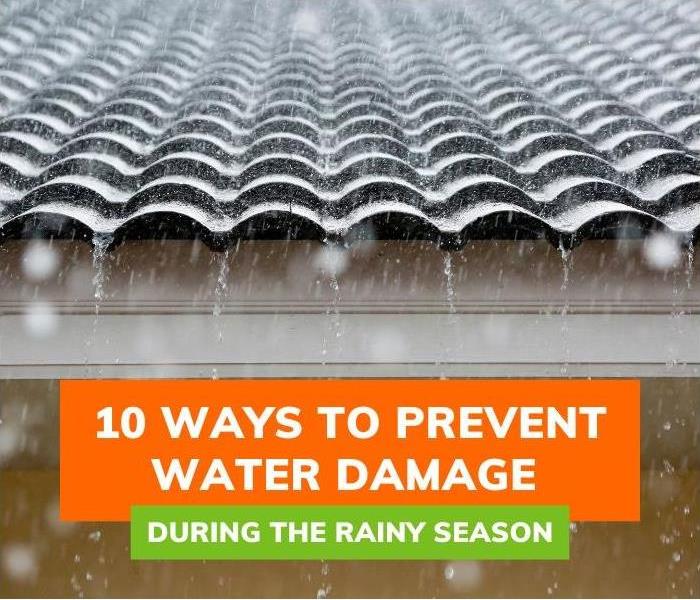 Rain falling on a rooftop
Rain falling on a rooftop
10 Effective Ways to Prevent Water Damage During the Rainy Season
Even a small leak could cause serious water damage when the rainy season arrives. Water gradually trickles inside, soaking your floors, walls, or furniture and encouraging bacterial growth. You may notice sagging ceilings, wet patches on the floor, black splotches on the wall,l and mysterious respiratory issues.
Once you learn how to prevent water damage during the rainy season, you'll reduce your risk of leaks, keeping your property clean and dry. Many of these tasks protect your home throughout the year, so make them part of your maintenance routine.
1. Inspect Your Roof
A roof inspection once or twice a year could protect your home from leaks and storm damage. Inspectors check your roof for cracked shingles, damaged gutters, unsealed vents, and other issues. They'll also check your attic for weak spots, such as poor insulation, rotting wood, pest infestations, and mildew growth. Afterward, your inspector gives you a report and makes recommendations.
If your roof needs maintenance, they may give you a price estimate. Taking care of small issues now could prevent costly repairs and protect your house from water leaks. Consider replacing your roof once it's 20 years old for older houses.
2. Check Your Foundation
Over time, your foundation can shift, developing cracks and holes that allow water to seep into your basement and crawlspace. Storm damage could worsen the cracks. Hire an inspector to check your foundation, then make repairs as necessary. Professionals can also waterproof your basement to reduce the risk of floods and protect your belongings.
3. Buy a Sump Pump
If you already have a sump pump, invest in one. Sump pumps reside in a basin on your basement floor. When the sensor detects rising waters, the device pumps water out of your house and sends it through the discharge line, which empties the water outside. This prevents floods that could ruin your basement.
Test the device by pouring water into the basin if you have a sump pump. The sump pump should drain the water away from your property. Sump pumps can go bad after long periods of non-use, so call a professional if the water isn't draining. You might need to order a replacement.
4. Use Sandbags
If you live in a high-risk area for floods, sandbags create a wall around your house that blocks the flow. Some water might seep through, but sand is a durable material that withstands strong forces, minimizing property damage. This tactic requires much time and effort but could save you tens of thousands of dollars in the long run.
Grab a few friends to help you fill burlap sacks 2/3rds of the way with sand, then build a sandbag wall around your house. Layer the bags like bricks to minimize cracks. Inside, place sandbags over your drains to avoid sewage backup.
5. Clean Your Gutters
Your gutter system draws rainwater away from your house. When rain trails down the roof, your gutters collect the water and drain it through downspouts. This prevents water build-up that could damage your home's structural integrity.
As you learn how to prevent water damage during the rainy season, start cleaning your gutters once or twice a year. Dead leaves, branches, and other debris build up in your gutters, causing blockages if you're not careful. This traps the rainwater and creates standing puddles.
Cleaning your gutters could even become a neighborhood event. Learn more about setting up HOA events to involve everyone on the street.
6. Seal Your Windows
Floodwater tends to leak through cracks around your doors and windows. Check the seals to ensure they're airtight, and replace damaged seals as quickly as possible. Make sure you close and lock your doors and windows before the storm hits.
You could also invest in impact glass for your windows. Impact glass looks like regular glass but withstands strong forces, making it less likely to crack during a storm. Sleet, hail, strong winds, and projectiles don't dent the surface.
7. Install a Flood Detection System
Flood detection systems alert you when they detect excess moisture, allowing you to quickly take action. Some devices send you smartphone notifications so that you can protect your property while you're away. They may shut off water valves automatically to reduce the risk of water damage.
You can install flood detection systems in places most susceptible to flooding, such as your attic, garage, or basement. Advanced systems attach directly to your water main and can shut off the entire water supply.
8. Secure Outdoor Objects
Strong winds can pick up unsecured items, such as lawn chairs, umbrellas, tables, and toys, and throw them against your house. The impact could crack a window or damage your walls, inviting water inside. When a storm is on the way, store your belongings inside and ensure that anything you can't move is securely bolted down.
Likewise, trim your trees to prevent loose branches from hitting your house. Look into professional tree removal if you have a dead or angled tree that could fall over and land on your property. One harsh wind could knock the tree over.
9. Elevate Your Valuables
Floodwaters could ruin your jewelry, photo albums, birth certificates, family heirlooms, electronics, and other valuables. Before the storm, seal your valuables in waterproof containers and store them in high areas, such as cabinets or high shelves. People who live in multi-story homes can store their valuables on the upper levels.
Basements are particularly prone to flooding, so ensure you're not storing anything you don't want to lose. If you stash items in your attic, check the space for leaks first. Rain exposure is just as dangerous as floodwater.
10. Clean Your Storm Drains
Storm drains are built into the street to collect excess rainwater and carry it to nearby waterways. Blocked storm drains lead to standing water that could leak into your house. Periodically, check your nearest storm drains for dead leaves, paper, and other debris. Trash can end up in the storm drain, so avoid littering.
Where to Find Mold Remediation
Water build-up creates a breeding ground for mold and mildew, which can damage your property and cause flu-like symptoms. To remediate mold, reach out to SERVPRO®. We'll stop the spread, eliminate the mold, and clean, dry, and disinfect your property to prevent further growth. Our experts also show you how to prevent water damage during the rainy season in the future.
Innovative Tenant Retention Programs for 2025
2/11/2025 (Permalink)
 Tenants receiving home keys
Tenants receiving home keys
Innovative Tenant Retention Programs for 2025
Tenant expectations have evolved and increased in 2025, requiring rental property owners to stay ahead by offering innovative and creative solutions. From smart home technology to sustainability and flexible leases, modern tenants seek additional amenities and a stronger sense of community.
Tenant-retention programs that offer these features and more will increase the chance of fostering tenant satisfaction and lead to long-term occupancy. Property managers and HOAs can strategically implement these moves to make their residential communities stand out in a competitive rental market.
Integrate Smart Home Tech
Many tenants use technology to make their living experience more comfortable. In 2025, landlords offering cutting-edge smart technology features in properties can benefit from this essential and effective way to retain tenants. In addition to enhancing tenants' comfort, energy-efficient solutions can reduce utility bills and save time with app-based monitoring capabilities.
Enhance rental units by installing voice-activated devices such as lighting fixtures and smart thermostats. Add video doorbells and upgraded smart locks to increase tenant security.
To increase tenant engagement, HOAs can host workshops that teach tenants how to get the most out of these innovative technologies. Additionally, consider working with local providers to get discounted smart home equipment and tenant installation services.
Provide Loyalty Incentives and Rewards
One of the innovative tenant retention programs 2025 is ushering in is reminiscent of retail loyalty programs. Encourage tenants to stay long-term by rewarding them for loyalty in meaningful ways. Introduce a system where tenants accrue points for paying their rent on time or providing referrals for new tenants.
Offer points-based rewards such as additional amenities or better parking perks. Provide valued tenants with tiered discounts on their rent or fee discounts based on their length of stay. Recognize tenants by providing them with discount vouchers or gift cards for milestones such as their rental anniversary.
Treat Pets Like Family
Creating a welcoming environment for tenants' furry family members is a growing trend and can improve tenant retention and satisfaction. Build designated dog park areas or dedicated green spaces for pet exercise. Additionally, consider adding pet washing stations or areas and offering pet grooming services through local providers.
Establish clear and reasonable policies for pet behavior and clean-up to ensure tenants and pets can live in harmony. Install waste-bag dispensers and garbage cans in strategic areas. When boosting resident engagement in your HOA, consider hosting community pet-training classes and adoption events.
Increase the Focus on Sustainability
As tenants become more environmentally and sustainability-focused, relevant amenities can attract them while reducing energy usage and related costs. Innovative tenant retention programs in 2025 can include amenities that focus on facilitating sustainable practices, such as providing compost bins and recycling stations.
Transition rental units to renewable energy sources, such as solar panels.
Incorporate native plants and sustainable landscaping into the property and provide tenants with community gardens or green spaces. Work with local partners to offer discounts to tenants who use eco-friendly methods for daily transportation. Encourage sustainable living practices through educational workshops and community sessions.
Offer Flexible Leases
Adapting leases to meet tenants’ diverse living arrangements can encourage loyalty and reduce turnover. Offer short-term, month-to-month, and co-living arrangements. Use simplified applications and digital tools to make the leasing process easier and more streamlined. Provide flexibility on move-in and move-out dates and allow tenants the option to transfer their existing rental leases.
To encourage lease renewals, offer discounts for early lease renewal signings. Entice tenants further by providing options to customize units, like choosing fixtures and wall colors.
Focus on Emergency Preparedness
Offering comprehensive safety measures and resources will provide tenants with peace of mind. Upon move-in, provide literature containing emergency evacuation plans and relevant resources. Educate new and existing tenants on the property's emergency procedures and local emergency contact points.
Provide fire safety equipment and run annual training sessions. Install secure areas or storm shelters in areas that experience extreme weather for tenant protection. Provide access to 24/7 emergency repair services for emergencies in tenant units, such as critical plumbing issues.
Provide Personalized Tenant Care
A personalized approach to support tenants can create a more satisfying resident experience. Innovative tenant retention programs 2025 involve using software tools to keep track of tenant concerns and preferences. Use this data to send personalized messages for holidays, birthdays, or anniversaries. Assign property managers to care for specific tenants and provide tailored support programs.
Respond promptly to tenant requests for maintenance and provide transparent repair completion timelines. After providing services, conduct follow-up visits to ensure tenants are satisfied with the maintenance work's outcome.
Add Co-Living and Shared Community Spaces
Appeal to tenants who embrace the shared economy trend and facilitate co-living by offering cost-effective, community-centered rental options. Designate specific units or homes for co-living arrangements. Enhance the experience for tenants by providing shared spaces like community kitchens, co-working areas, or language study programs.
Introduce a program to “borrow and share” items such as bicycles, tools or outdoor equipment. Work with tenants to develop programs for community-shared childcare or carpooling. Consider facilitating communal purchases for groceries, subscription services, or utilities.
Make the Property EV-Friendly
As more people adopt electric vehicles, accommodating tenants who own EVs can set the community apart. Support the move to make EVs mainstream by providing tenants with resources that cover government incentives and grants for electric vehicle purchases.
Offer discounts on parking spots for tenants that drive EVs and install EV charging stations for easy availability throughout the neighborhood or complex. Host community workshops that discuss transitioning to electric vehicles and work with automakers to provide exclusive tenant-only discounts on EV purchases.
Attract Digital Nomads
Adding features that attract digital nomads can provide access to a new and rapidly growing tenant demographic. Offer fully furnished rental units with flexible lease terms. Provide lockable storage options for tenants who frequently travel.
Ensure the community has seamless Wi-Fi coverage throughout so tenants can work anywhere. Partner with travel and co-working organizations to provide useful tenant perks. To attract an international tenant base, offer language classes and relevant cultural events.
Go Beyond "A Place to Live"
Tenant retention in 2025 is about creating a future-ready, comfortable, and engaging environment. Property owners and HOA management can enhance tenant relationships and cut turnover by integrating features like flexible leases, co-working spaces, and sustainability initiatives.
Providing tenants with a healthy and safe living environment is essential. Successfully addressing maintenance requests and issues such as poor ventilation or a mold problem can significantly enhance tenant satisfaction. Ensuring responsiveness and prompt repairs builds trust and increases long-term commitment. Let the professionals at SERVPRO® handle mold issues, water damage, and related problems with the quality tenants appreciate and expect. Contact us today to see how we can help.
Creative HOA Event Ideas to Engage Residents
2/5/2025 (Permalink)
 Group of residents socializing
Group of residents socializing
Creative HOA Event Ideas to Engage Residents
Are you struggling to bring the community together in your homeowners' association? Lack of engagement from HOA residents is a struggle many HOA managers and board members face. You desperately want to bring neighbors together to build a sense of community organically. The truth is that residents sometimes need a reason to engage. That's why hosting events is one of the best tips for how to engage your community as an HOA. There's nothing better than getting out, mingling with the neighbors, and building a sense of belonging! These 10 creative HOA event ideas to engage residents will help you kick things off.
1. Host a Movie Night Under the Stars
This is one of the classic creative HOA event ideas for engaging residents. If your community has a large outdoor space, this is the perfect spot for hosting a movie night on the lawn. Here are some tips for hosting a flawless night
- Run a poll a few days before the movie night to let residents pick the movie.
- Only select family-friendly, noncontroversial movies that appeal to everyone.
- Utilize any seating that your HOA already has available. Ask attendees to bring blankets and lawn chairs to use during the movie.
- Encourage residents to bring their food and snacks.
- Consider investing in renting or purchasing a popcorn machine that will allow your HOA to hand out free popcorn on movie nights.
- With sunset times shifting nightly, there's no need to set a specific time for movie night. Generally, starting 15 minutes after sunset will provide the best visibility for movie viewers. Ask that residents arrive 30 minutes before sunset to prevent any shuffling while the movie is starting.
- Make trash cans readily available to prevent littering.
2. Start a Community Garden
A community garden is a great way to bring together established and aspiring greenthumbs in your HOA. Pick a shared area with enough flat green space to accommodate a large garden. The garden can be divided into smaller plots that individual residents can claim. You can even host a garden competition at the end of the growing season that allows residents to showcase their produce and flowers!
3. Host an Annual Yard Sale
A community-wide yard sale offers an opportunity for residents to declutter in a fun way! By hosting a single event, you can boost foot traffic for each yard sale to make it "worth it" for residents to clear out unwanted items from their homes. Additionally, a community-wide yard sale offers a fun opportunity for neighbors to hop from house to house to check out hidden treasures being sold by their neighbors. Your HOA can even consider asking residents to pool all the proceeds together to donate them to a good cause.
4. Plan a Field Trip
Create some opportunities for residents to explore the local area as a group by hosting field trips. These trips don't have to be elaborate. Consider a trip to a nearby mall or outlet center, a picnic in a local park, a tour of a museum, a night of bowling, and similar outings. Field trips are great for bringing together neighbors who might not interact on a regular basis.
5. Throw a Block Party
A summertime block party is the ultimate way for neighbors to connect! Residents can enjoy showing off their favorite recipes for chili, ribs, strawberry shortcake, and other summertime staples when neighbors stop by during the party. Everyone who attends gets to enjoy a nibble and some conversation at each stop! An annual block party is something that residents can look forward to all year long.
6. Throw a Food Truck Party
If your HOA is sizable, consider assembling a list of local food trucks to throw a food truck party. This is a great opportunity for residents to sample a variety of food options. It also helps to support local businesses. Your HOA board will need to decide whether you'd like to open the food truck festival to the general public or keep it for residents only. Charging a small entry fee for outsiders could make this a great fundraising opportunity for your HOA. Always talk with your local zoning board about any permits that might be needed to host this type of event.
7. Host Trivia Nights
Trivia nights stir up friendly competitions and camaraderie. Many residents are looking for fun things to do on Friday and Saturday nights. Bringing the "going out" experience to the community can be a great way to help neighbors meet one another. Generally, these events work best as adults-only events. You can encourage residents to participate in trivia nights and game nights hosted in a common area by serving snacks and drinks.
8. Offer Educational Workshops
One smart way to bring HOA residents out of their homes is to offer something of value. Hosting educational workshops and seminars in a shared space can bring out curious residents. Some examples might include art workshops, DIY home tutorials from local carpenters, emergency preparedness workshops from local firefighters or experts, or financial planning seminars from local retirement experts. Local financial planners, estate planners, and lawyers will often offer workshops and seminars for free in exchange for being able to leave their business cards with attendees.
9. Offer Weekly Fitness Classes
If you're looking for recurring HOA events, consider hosting weekly fitness classes that give residents a reason to get out of the house for a bit to burn calories and build strength. Generally, it's best to go with low-impact, easy-to-learn workouts that will appeal to the largest number of residents. This might include things like dance exercises, yoga, or resistance workouts. When working with a local fitness instructor, consider asking them to offer one free class a week that allows attendees to pay for a more advanced class on a different day if they'd like to follow up with something more intense.
Don't stress if you're having trouble finding a fitness instructor to offer a class in your HOA community. The easy default option is to start a weekly walking club. A leader within your community can plan a walking route that includes stops for stretches.
10. Host an Annual Silent Auction
A silent auction is a great reason for residents to get dressed up for a fun evening out! While silent auctions are typically held at halls or ballrooms, your HOA board can "dress up" your community's communal area to look like an enchanted venue for the night. During a silent auction, residents can bid on antiques, event tickets, art, and other valuables. You can choose to either use the money raised for special projects in the HOA or donate it to a special charity.
Making Your HOA the Best Place to Live
These creative HOA event ideas to engage residents bring life to a community! Events on the calendar give HOA residents something to look forward to each month. However, what happens in between fun HOA events also matters. Whether you use an HOA management company or handle every detail of day-to-day life on your own as a manager or board member, the responsibility for operating a safe and livable environment falls on you. That's why it's important to stay on top of issues like peeling paint, crumbling sidewalks, and mold growth before they disrupt quality of life.
If you have concerns about mold infestations at your HOA, it's important to seek a professional opinion right away. With water damage and mold, the clock is always ticking until severe structural damage and health problems begin to crop up. Call for restoration services today!






 24/7 Emergency Service
24/7 Emergency Service









